Leadership and Change for Organizational Progress - QAB020X603A Report
VerifiedAdded on 2022/09/11
|45
|10679
|34
Report
AI Summary
This report delves into the critical relationship between leadership and organizational change, emphasizing the roles of innovation and vision in driving progress. It begins with a comprehensive literature review, exploring various leadership concepts, innovative approaches, and the significance of vision in modern organizations. The study then outlines its methodology, including research philosophy, approach, design, data collection, and analysis techniques. The findings, presented through reliability and validity analyses, frequency distributions, descriptive statistics, and correlation and regression analyses, highlight the impact of innovation and vision on leadership competencies and the successful implementation of change management. The report also discusses the limitations, such as the scope not including differentiation between radical and incremental change, while suggesting potential areas for future research. Overall, this report provides a detailed analysis of leadership's influence on organizational change and the importance of vision and innovation for achieving strategic objectives.
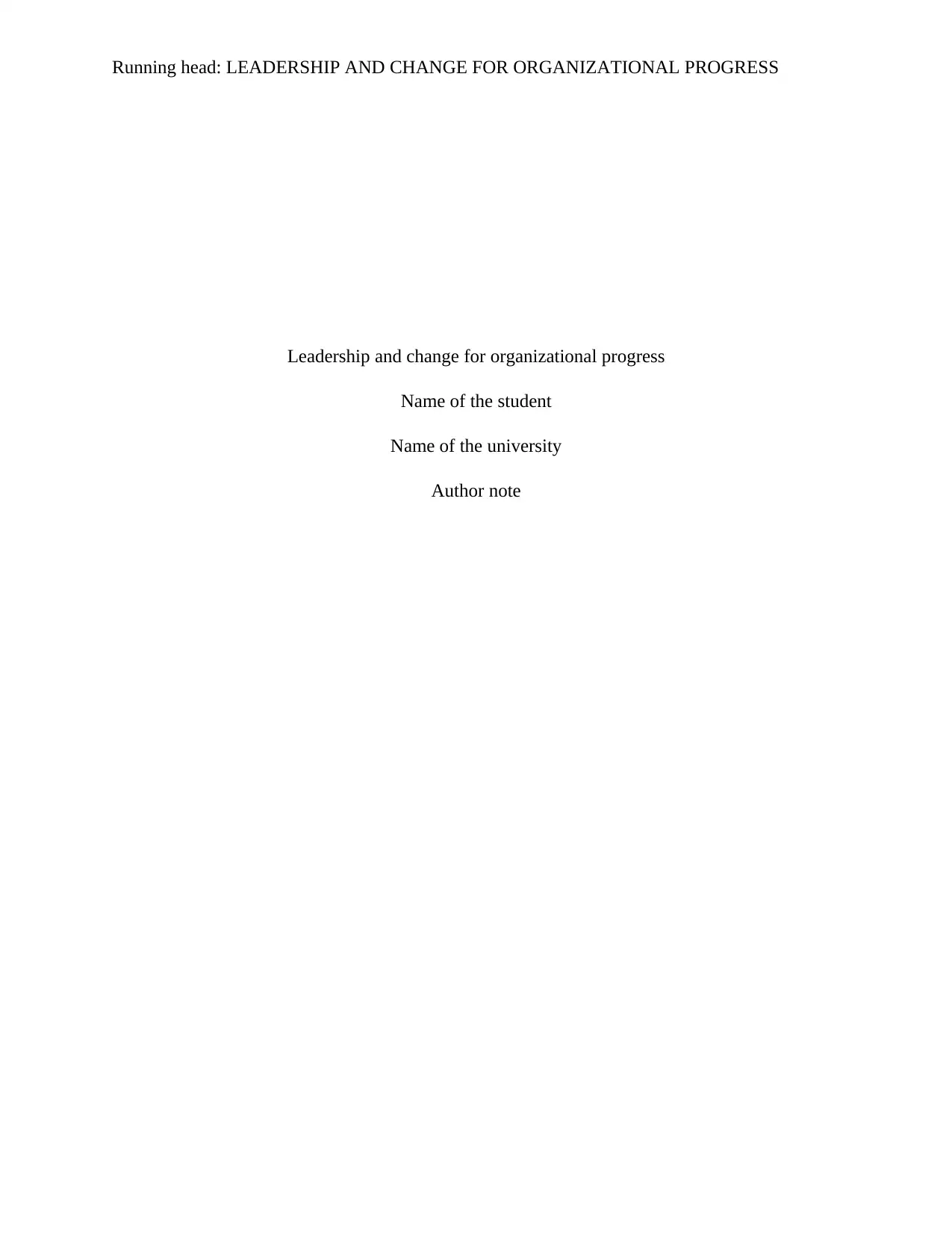
Running head: LEADERSHIP AND CHANGE FOR ORGANIZATIONAL PROGRESS
Leadership and change for organizational progress
Name of the student
Name of the university
Author note
Leadership and change for organizational progress
Name of the student
Name of the university
Author note
Paraphrase This Document
Need a fresh take? Get an instant paraphrase of this document with our AI Paraphraser
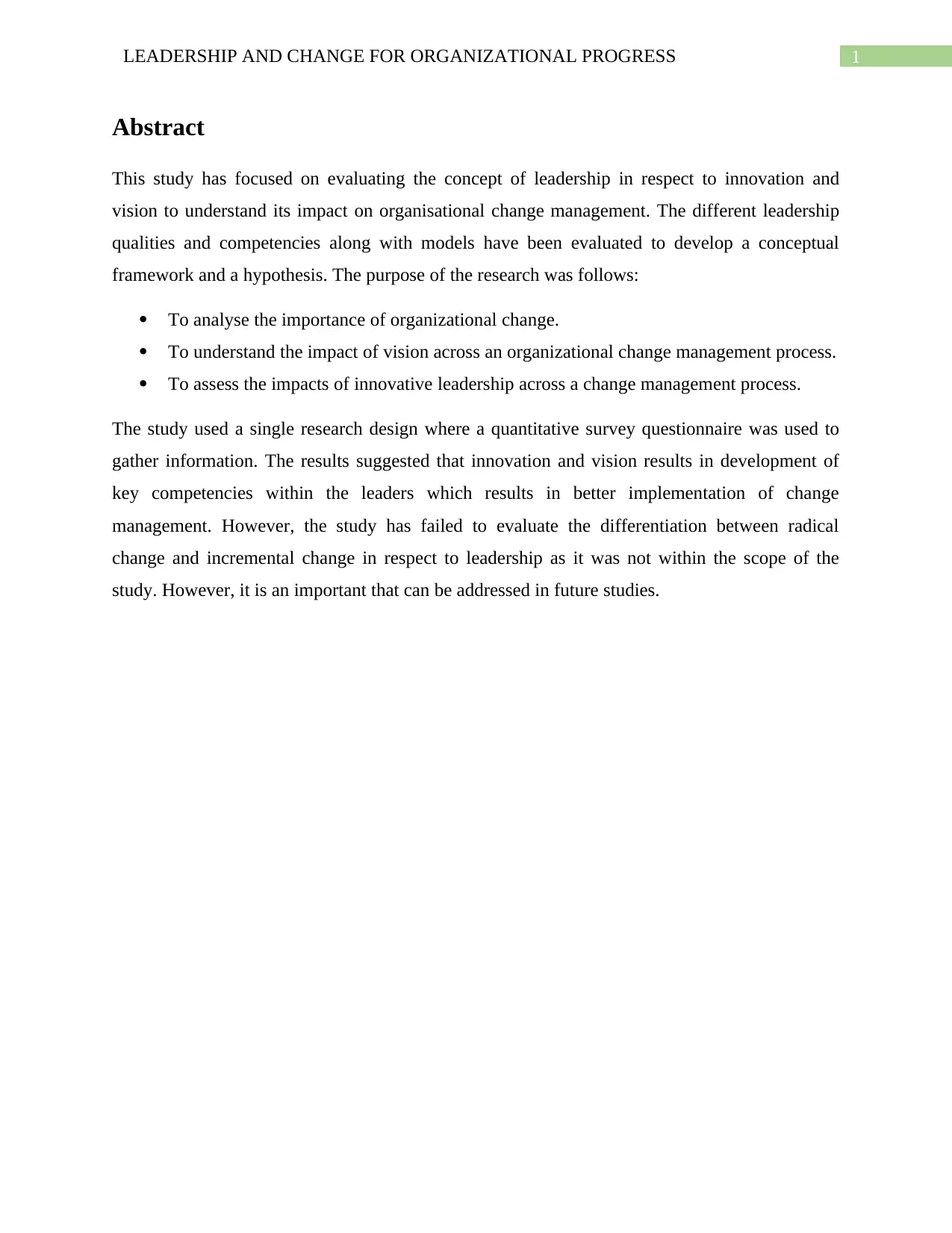
1LEADERSHIP AND CHANGE FOR ORGANIZATIONAL PROGRESS
Abstract
This study has focused on evaluating the concept of leadership in respect to innovation and
vision to understand its impact on organisational change management. The different leadership
qualities and competencies along with models have been evaluated to develop a conceptual
framework and a hypothesis. The purpose of the research was follows:
To analyse the importance of organizational change.
To understand the impact of vision across an organizational change management process.
To assess the impacts of innovative leadership across a change management process.
The study used a single research design where a quantitative survey questionnaire was used to
gather information. The results suggested that innovation and vision results in development of
key competencies within the leaders which results in better implementation of change
management. However, the study has failed to evaluate the differentiation between radical
change and incremental change in respect to leadership as it was not within the scope of the
study. However, it is an important that can be addressed in future studies.
Abstract
This study has focused on evaluating the concept of leadership in respect to innovation and
vision to understand its impact on organisational change management. The different leadership
qualities and competencies along with models have been evaluated to develop a conceptual
framework and a hypothesis. The purpose of the research was follows:
To analyse the importance of organizational change.
To understand the impact of vision across an organizational change management process.
To assess the impacts of innovative leadership across a change management process.
The study used a single research design where a quantitative survey questionnaire was used to
gather information. The results suggested that innovation and vision results in development of
key competencies within the leaders which results in better implementation of change
management. However, the study has failed to evaluate the differentiation between radical
change and incremental change in respect to leadership as it was not within the scope of the
study. However, it is an important that can be addressed in future studies.
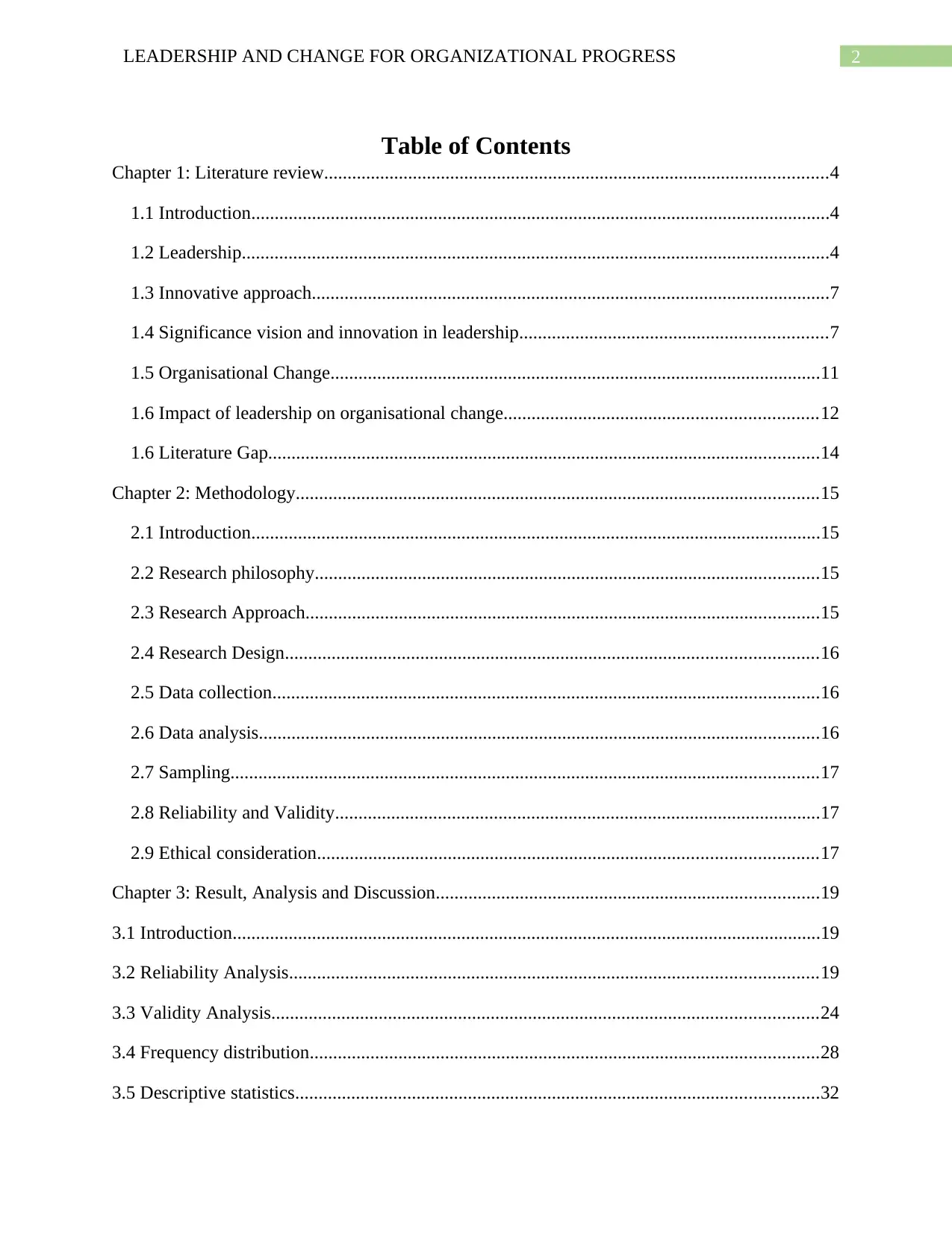
2LEADERSHIP AND CHANGE FOR ORGANIZATIONAL PROGRESS
Table of Contents
Chapter 1: Literature review............................................................................................................4
1.1 Introduction............................................................................................................................4
1.2 Leadership..............................................................................................................................4
1.3 Innovative approach...............................................................................................................7
1.4 Significance vision and innovation in leadership..................................................................7
1.5 Organisational Change.........................................................................................................11
1.6 Impact of leadership on organisational change...................................................................12
1.6 Literature Gap......................................................................................................................14
Chapter 2: Methodology................................................................................................................15
2.1 Introduction..........................................................................................................................15
2.2 Research philosophy............................................................................................................15
2.3 Research Approach..............................................................................................................15
2.4 Research Design..................................................................................................................16
2.5 Data collection.....................................................................................................................16
2.6 Data analysis........................................................................................................................16
2.7 Sampling..............................................................................................................................17
2.8 Reliability and Validity........................................................................................................17
2.9 Ethical consideration...........................................................................................................17
Chapter 3: Result, Analysis and Discussion..................................................................................19
3.1 Introduction..............................................................................................................................19
3.2 Reliability Analysis.................................................................................................................19
3.3 Validity Analysis.....................................................................................................................24
3.4 Frequency distribution.............................................................................................................28
3.5 Descriptive statistics................................................................................................................32
Table of Contents
Chapter 1: Literature review............................................................................................................4
1.1 Introduction............................................................................................................................4
1.2 Leadership..............................................................................................................................4
1.3 Innovative approach...............................................................................................................7
1.4 Significance vision and innovation in leadership..................................................................7
1.5 Organisational Change.........................................................................................................11
1.6 Impact of leadership on organisational change...................................................................12
1.6 Literature Gap......................................................................................................................14
Chapter 2: Methodology................................................................................................................15
2.1 Introduction..........................................................................................................................15
2.2 Research philosophy............................................................................................................15
2.3 Research Approach..............................................................................................................15
2.4 Research Design..................................................................................................................16
2.5 Data collection.....................................................................................................................16
2.6 Data analysis........................................................................................................................16
2.7 Sampling..............................................................................................................................17
2.8 Reliability and Validity........................................................................................................17
2.9 Ethical consideration...........................................................................................................17
Chapter 3: Result, Analysis and Discussion..................................................................................19
3.1 Introduction..............................................................................................................................19
3.2 Reliability Analysis.................................................................................................................19
3.3 Validity Analysis.....................................................................................................................24
3.4 Frequency distribution.............................................................................................................28
3.5 Descriptive statistics................................................................................................................32
⊘ This is a preview!⊘
Do you want full access?
Subscribe today to unlock all pages.

Trusted by 1+ million students worldwide
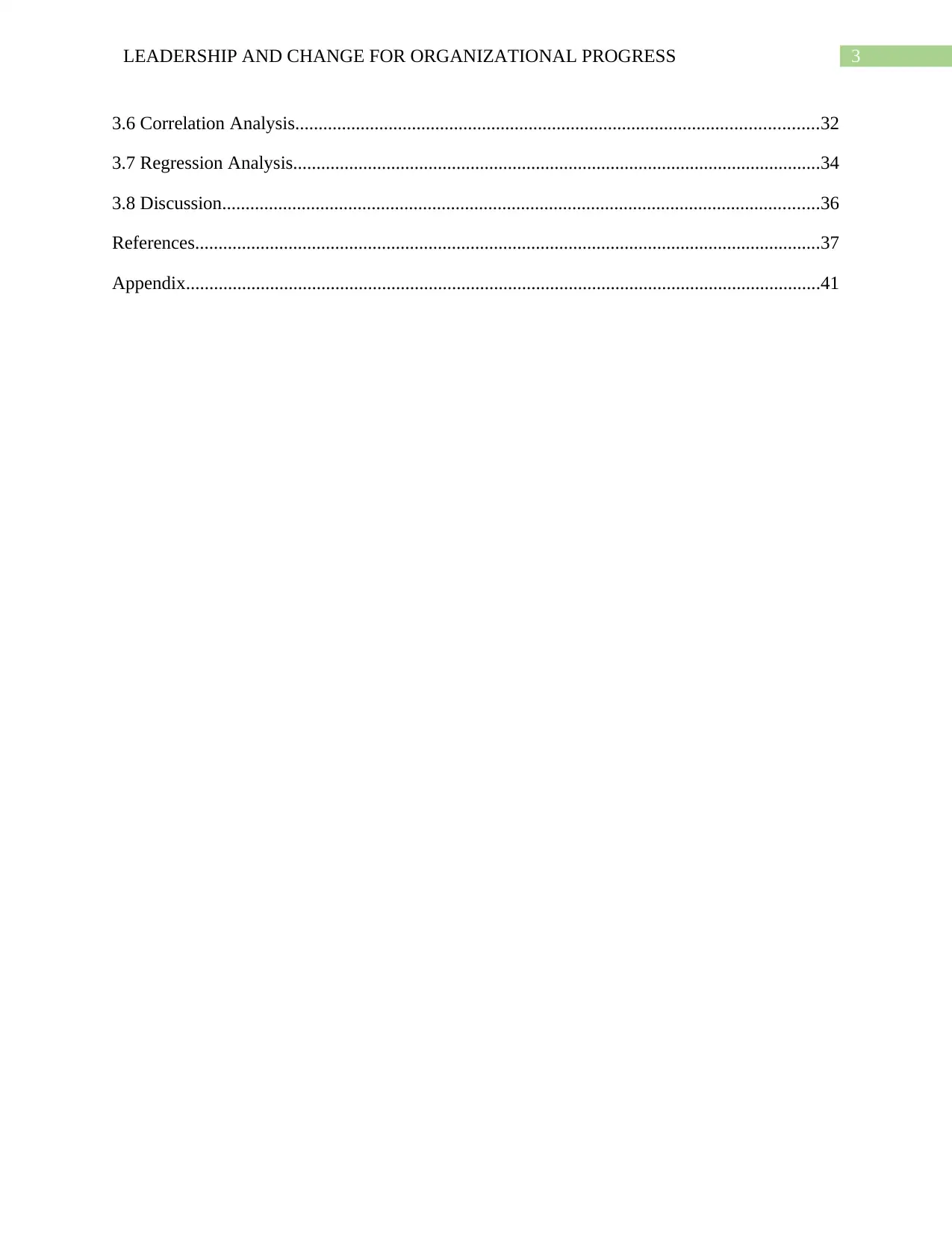
3LEADERSHIP AND CHANGE FOR ORGANIZATIONAL PROGRESS
3.6 Correlation Analysis................................................................................................................32
3.7 Regression Analysis.................................................................................................................34
3.8 Discussion................................................................................................................................36
References......................................................................................................................................37
Appendix........................................................................................................................................41
3.6 Correlation Analysis................................................................................................................32
3.7 Regression Analysis.................................................................................................................34
3.8 Discussion................................................................................................................................36
References......................................................................................................................................37
Appendix........................................................................................................................................41
Paraphrase This Document
Need a fresh take? Get an instant paraphrase of this document with our AI Paraphraser
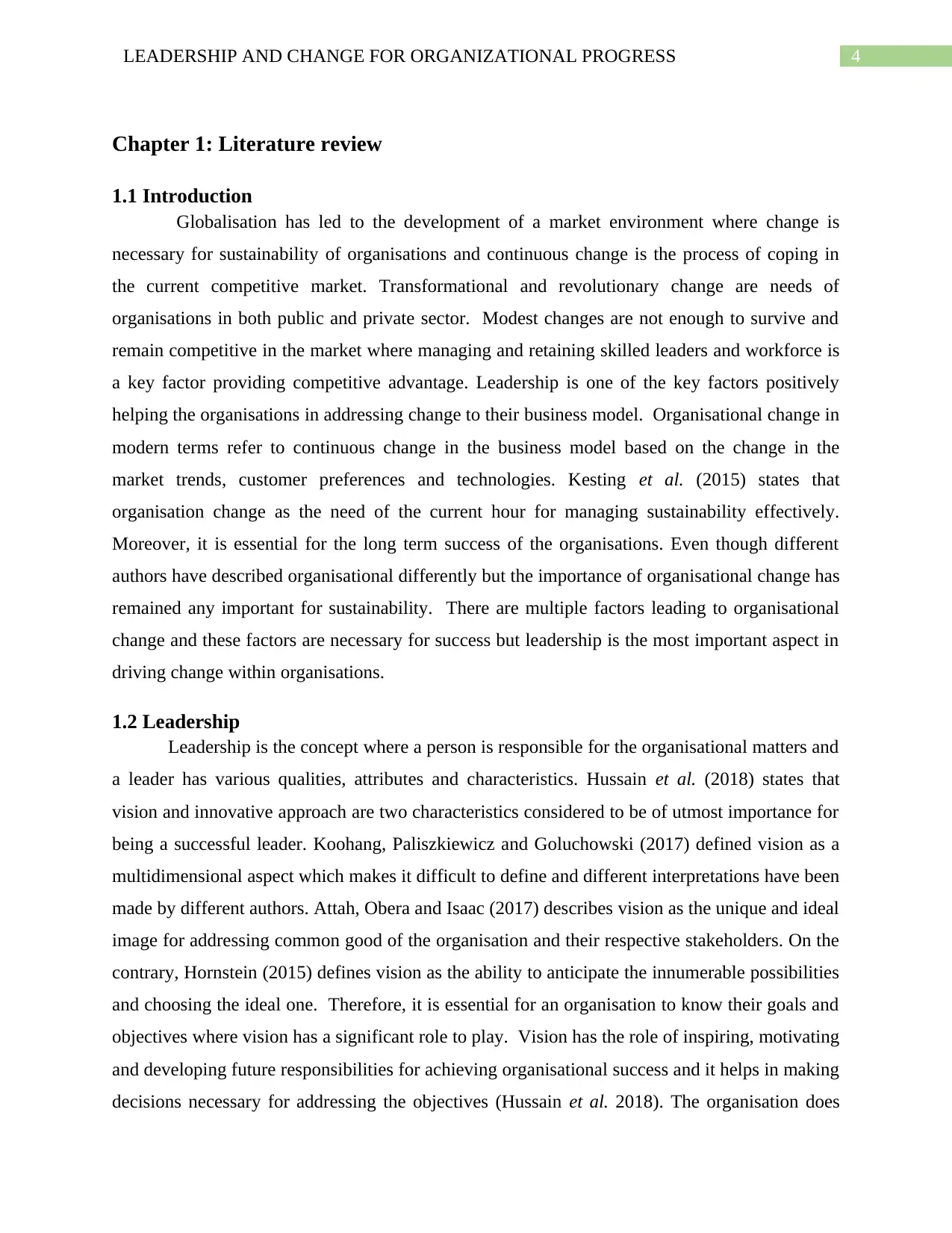
4LEADERSHIP AND CHANGE FOR ORGANIZATIONAL PROGRESS
Chapter 1: Literature review
1.1 Introduction
Globalisation has led to the development of a market environment where change is
necessary for sustainability of organisations and continuous change is the process of coping in
the current competitive market. Transformational and revolutionary change are needs of
organisations in both public and private sector. Modest changes are not enough to survive and
remain competitive in the market where managing and retaining skilled leaders and workforce is
a key factor providing competitive advantage. Leadership is one of the key factors positively
helping the organisations in addressing change to their business model. Organisational change in
modern terms refer to continuous change in the business model based on the change in the
market trends, customer preferences and technologies. Kesting et al. (2015) states that
organisation change as the need of the current hour for managing sustainability effectively.
Moreover, it is essential for the long term success of the organisations. Even though different
authors have described organisational differently but the importance of organisational change has
remained any important for sustainability. There are multiple factors leading to organisational
change and these factors are necessary for success but leadership is the most important aspect in
driving change within organisations.
1.2 Leadership
Leadership is the concept where a person is responsible for the organisational matters and
a leader has various qualities, attributes and characteristics. Hussain et al. (2018) states that
vision and innovative approach are two characteristics considered to be of utmost importance for
being a successful leader. Koohang, Paliszkiewicz and Goluchowski (2017) defined vision as a
multidimensional aspect which makes it difficult to define and different interpretations have been
made by different authors. Attah, Obera and Isaac (2017) describes vision as the unique and ideal
image for addressing common good of the organisation and their respective stakeholders. On the
contrary, Hornstein (2015) defines vision as the ability to anticipate the innumerable possibilities
and choosing the ideal one. Therefore, it is essential for an organisation to know their goals and
objectives where vision has a significant role to play. Vision has the role of inspiring, motivating
and developing future responsibilities for achieving organisational success and it helps in making
decisions necessary for addressing the objectives (Hussain et al. 2018). The organisation does
Chapter 1: Literature review
1.1 Introduction
Globalisation has led to the development of a market environment where change is
necessary for sustainability of organisations and continuous change is the process of coping in
the current competitive market. Transformational and revolutionary change are needs of
organisations in both public and private sector. Modest changes are not enough to survive and
remain competitive in the market where managing and retaining skilled leaders and workforce is
a key factor providing competitive advantage. Leadership is one of the key factors positively
helping the organisations in addressing change to their business model. Organisational change in
modern terms refer to continuous change in the business model based on the change in the
market trends, customer preferences and technologies. Kesting et al. (2015) states that
organisation change as the need of the current hour for managing sustainability effectively.
Moreover, it is essential for the long term success of the organisations. Even though different
authors have described organisational differently but the importance of organisational change has
remained any important for sustainability. There are multiple factors leading to organisational
change and these factors are necessary for success but leadership is the most important aspect in
driving change within organisations.
1.2 Leadership
Leadership is the concept where a person is responsible for the organisational matters and
a leader has various qualities, attributes and characteristics. Hussain et al. (2018) states that
vision and innovative approach are two characteristics considered to be of utmost importance for
being a successful leader. Koohang, Paliszkiewicz and Goluchowski (2017) defined vision as a
multidimensional aspect which makes it difficult to define and different interpretations have been
made by different authors. Attah, Obera and Isaac (2017) describes vision as the unique and ideal
image for addressing common good of the organisation and their respective stakeholders. On the
contrary, Hornstein (2015) defines vision as the ability to anticipate the innumerable possibilities
and choosing the ideal one. Therefore, it is essential for an organisation to know their goals and
objectives where vision has a significant role to play. Vision has the role of inspiring, motivating
and developing future responsibilities for achieving organisational success and it helps in making
decisions necessary for addressing the objectives (Hussain et al. 2018). The organisation does
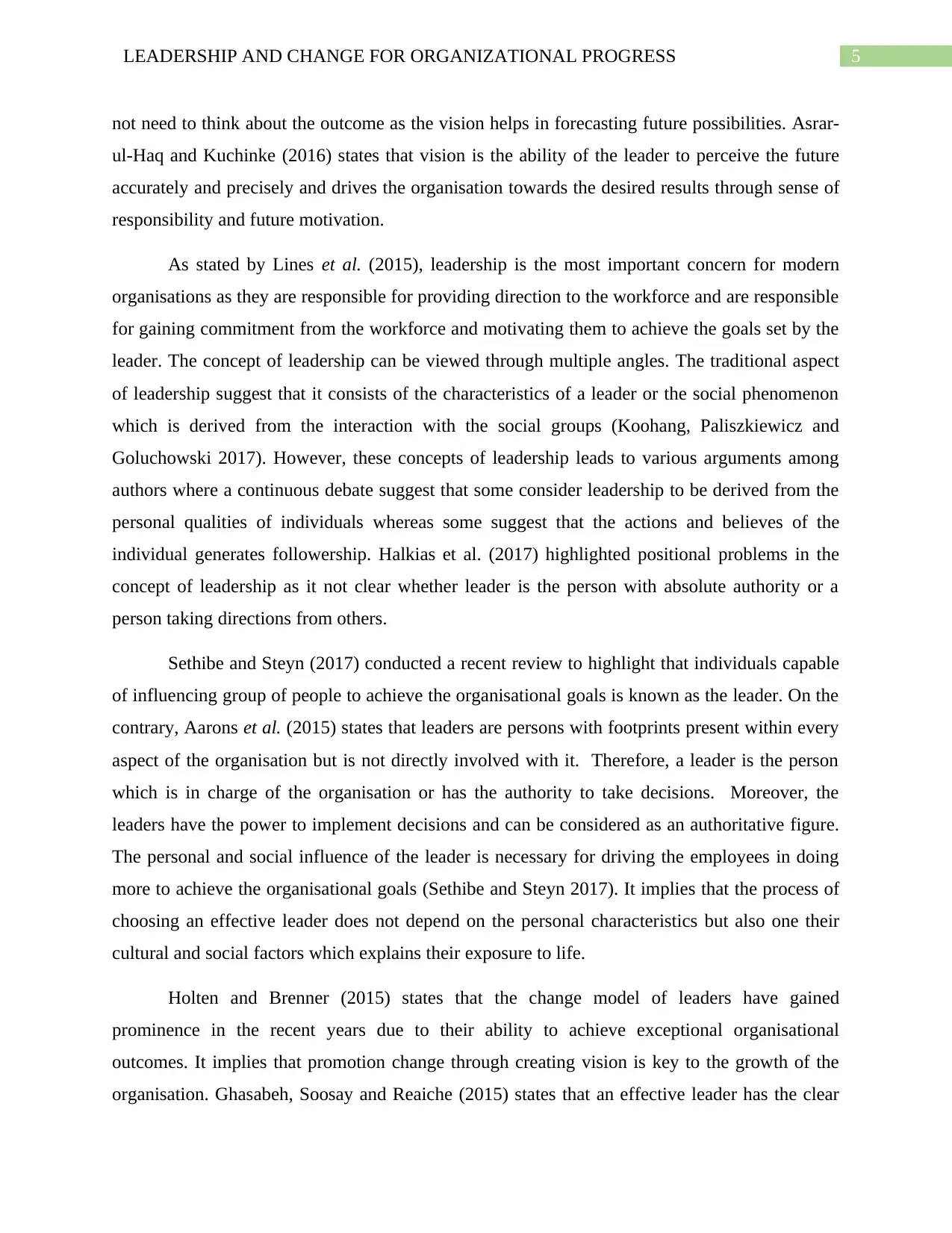
5LEADERSHIP AND CHANGE FOR ORGANIZATIONAL PROGRESS
not need to think about the outcome as the vision helps in forecasting future possibilities. Asrar-
ul-Haq and Kuchinke (2016) states that vision is the ability of the leader to perceive the future
accurately and precisely and drives the organisation towards the desired results through sense of
responsibility and future motivation.
As stated by Lines et al. (2015), leadership is the most important concern for modern
organisations as they are responsible for providing direction to the workforce and are responsible
for gaining commitment from the workforce and motivating them to achieve the goals set by the
leader. The concept of leadership can be viewed through multiple angles. The traditional aspect
of leadership suggest that it consists of the characteristics of a leader or the social phenomenon
which is derived from the interaction with the social groups (Koohang, Paliszkiewicz and
Goluchowski 2017). However, these concepts of leadership leads to various arguments among
authors where a continuous debate suggest that some consider leadership to be derived from the
personal qualities of individuals whereas some suggest that the actions and believes of the
individual generates followership. Halkias et al. (2017) highlighted positional problems in the
concept of leadership as it not clear whether leader is the person with absolute authority or a
person taking directions from others.
Sethibe and Steyn (2017) conducted a recent review to highlight that individuals capable
of influencing group of people to achieve the organisational goals is known as the leader. On the
contrary, Aarons et al. (2015) states that leaders are persons with footprints present within every
aspect of the organisation but is not directly involved with it. Therefore, a leader is the person
which is in charge of the organisation or has the authority to take decisions. Moreover, the
leaders have the power to implement decisions and can be considered as an authoritative figure.
The personal and social influence of the leader is necessary for driving the employees in doing
more to achieve the organisational goals (Sethibe and Steyn 2017). It implies that the process of
choosing an effective leader does not depend on the personal characteristics but also one their
cultural and social factors which explains their exposure to life.
Holten and Brenner (2015) states that the change model of leaders have gained
prominence in the recent years due to their ability to achieve exceptional organisational
outcomes. It implies that promotion change through creating vision is key to the growth of the
organisation. Ghasabeh, Soosay and Reaiche (2015) states that an effective leader has the clear
not need to think about the outcome as the vision helps in forecasting future possibilities. Asrar-
ul-Haq and Kuchinke (2016) states that vision is the ability of the leader to perceive the future
accurately and precisely and drives the organisation towards the desired results through sense of
responsibility and future motivation.
As stated by Lines et al. (2015), leadership is the most important concern for modern
organisations as they are responsible for providing direction to the workforce and are responsible
for gaining commitment from the workforce and motivating them to achieve the goals set by the
leader. The concept of leadership can be viewed through multiple angles. The traditional aspect
of leadership suggest that it consists of the characteristics of a leader or the social phenomenon
which is derived from the interaction with the social groups (Koohang, Paliszkiewicz and
Goluchowski 2017). However, these concepts of leadership leads to various arguments among
authors where a continuous debate suggest that some consider leadership to be derived from the
personal qualities of individuals whereas some suggest that the actions and believes of the
individual generates followership. Halkias et al. (2017) highlighted positional problems in the
concept of leadership as it not clear whether leader is the person with absolute authority or a
person taking directions from others.
Sethibe and Steyn (2017) conducted a recent review to highlight that individuals capable
of influencing group of people to achieve the organisational goals is known as the leader. On the
contrary, Aarons et al. (2015) states that leaders are persons with footprints present within every
aspect of the organisation but is not directly involved with it. Therefore, a leader is the person
which is in charge of the organisation or has the authority to take decisions. Moreover, the
leaders have the power to implement decisions and can be considered as an authoritative figure.
The personal and social influence of the leader is necessary for driving the employees in doing
more to achieve the organisational goals (Sethibe and Steyn 2017). It implies that the process of
choosing an effective leader does not depend on the personal characteristics but also one their
cultural and social factors which explains their exposure to life.
Holten and Brenner (2015) states that the change model of leaders have gained
prominence in the recent years due to their ability to achieve exceptional organisational
outcomes. It implies that promotion change through creating vision is key to the growth of the
organisation. Ghasabeh, Soosay and Reaiche (2015) states that an effective leader has the clear
⊘ This is a preview!⊘
Do you want full access?
Subscribe today to unlock all pages.

Trusted by 1+ million students worldwide
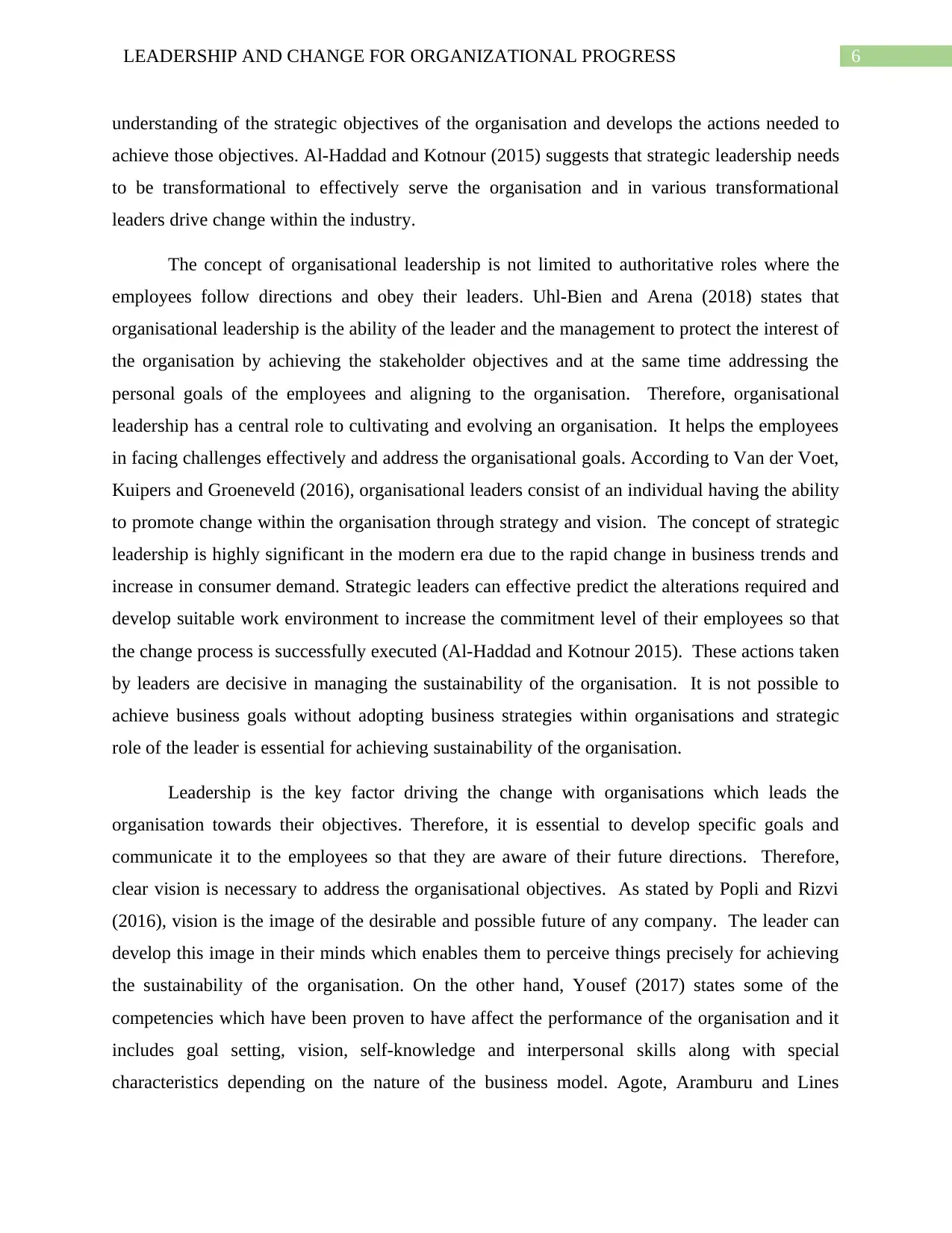
6LEADERSHIP AND CHANGE FOR ORGANIZATIONAL PROGRESS
understanding of the strategic objectives of the organisation and develops the actions needed to
achieve those objectives. Al-Haddad and Kotnour (2015) suggests that strategic leadership needs
to be transformational to effectively serve the organisation and in various transformational
leaders drive change within the industry.
The concept of organisational leadership is not limited to authoritative roles where the
employees follow directions and obey their leaders. Uhl-Bien and Arena (2018) states that
organisational leadership is the ability of the leader and the management to protect the interest of
the organisation by achieving the stakeholder objectives and at the same time addressing the
personal goals of the employees and aligning to the organisation. Therefore, organisational
leadership has a central role to cultivating and evolving an organisation. It helps the employees
in facing challenges effectively and address the organisational goals. According to Van der Voet,
Kuipers and Groeneveld (2016), organisational leaders consist of an individual having the ability
to promote change within the organisation through strategy and vision. The concept of strategic
leadership is highly significant in the modern era due to the rapid change in business trends and
increase in consumer demand. Strategic leaders can effective predict the alterations required and
develop suitable work environment to increase the commitment level of their employees so that
the change process is successfully executed (Al-Haddad and Kotnour 2015). These actions taken
by leaders are decisive in managing the sustainability of the organisation. It is not possible to
achieve business goals without adopting business strategies within organisations and strategic
role of the leader is essential for achieving sustainability of the organisation.
Leadership is the key factor driving the change with organisations which leads the
organisation towards their objectives. Therefore, it is essential to develop specific goals and
communicate it to the employees so that they are aware of their future directions. Therefore,
clear vision is necessary to address the organisational objectives. As stated by Popli and Rizvi
(2016), vision is the image of the desirable and possible future of any company. The leader can
develop this image in their minds which enables them to perceive things precisely for achieving
the sustainability of the organisation. On the other hand, Yousef (2017) states some of the
competencies which have been proven to have affect the performance of the organisation and it
includes goal setting, vision, self-knowledge and interpersonal skills along with special
characteristics depending on the nature of the business model. Agote, Aramburu and Lines
understanding of the strategic objectives of the organisation and develops the actions needed to
achieve those objectives. Al-Haddad and Kotnour (2015) suggests that strategic leadership needs
to be transformational to effectively serve the organisation and in various transformational
leaders drive change within the industry.
The concept of organisational leadership is not limited to authoritative roles where the
employees follow directions and obey their leaders. Uhl-Bien and Arena (2018) states that
organisational leadership is the ability of the leader and the management to protect the interest of
the organisation by achieving the stakeholder objectives and at the same time addressing the
personal goals of the employees and aligning to the organisation. Therefore, organisational
leadership has a central role to cultivating and evolving an organisation. It helps the employees
in facing challenges effectively and address the organisational goals. According to Van der Voet,
Kuipers and Groeneveld (2016), organisational leaders consist of an individual having the ability
to promote change within the organisation through strategy and vision. The concept of strategic
leadership is highly significant in the modern era due to the rapid change in business trends and
increase in consumer demand. Strategic leaders can effective predict the alterations required and
develop suitable work environment to increase the commitment level of their employees so that
the change process is successfully executed (Al-Haddad and Kotnour 2015). These actions taken
by leaders are decisive in managing the sustainability of the organisation. It is not possible to
achieve business goals without adopting business strategies within organisations and strategic
role of the leader is essential for achieving sustainability of the organisation.
Leadership is the key factor driving the change with organisations which leads the
organisation towards their objectives. Therefore, it is essential to develop specific goals and
communicate it to the employees so that they are aware of their future directions. Therefore,
clear vision is necessary to address the organisational objectives. As stated by Popli and Rizvi
(2016), vision is the image of the desirable and possible future of any company. The leader can
develop this image in their minds which enables them to perceive things precisely for achieving
the sustainability of the organisation. On the other hand, Yousef (2017) states some of the
competencies which have been proven to have affect the performance of the organisation and it
includes goal setting, vision, self-knowledge and interpersonal skills along with special
characteristics depending on the nature of the business model. Agote, Aramburu and Lines
Paraphrase This Document
Need a fresh take? Get an instant paraphrase of this document with our AI Paraphraser
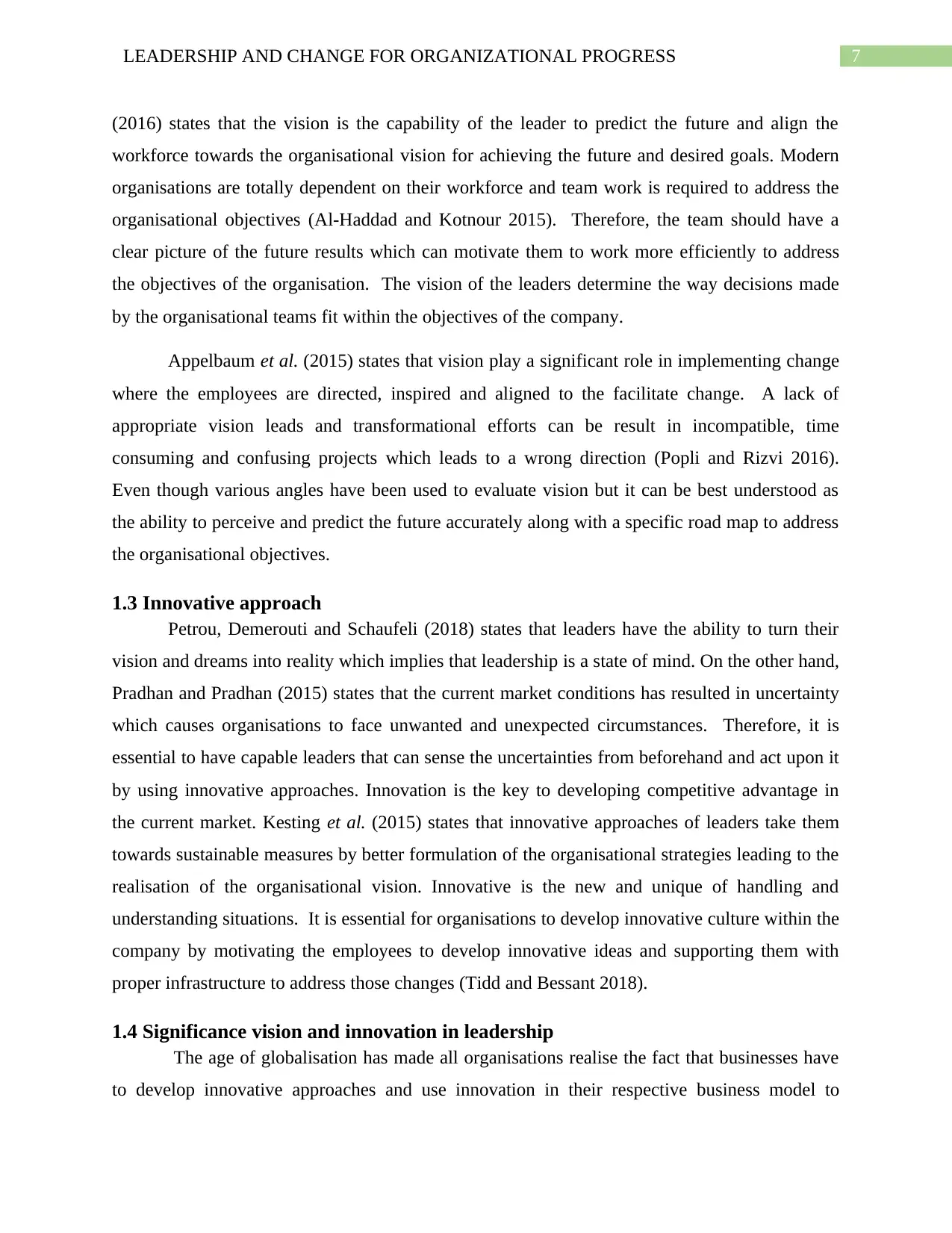
7LEADERSHIP AND CHANGE FOR ORGANIZATIONAL PROGRESS
(2016) states that the vision is the capability of the leader to predict the future and align the
workforce towards the organisational vision for achieving the future and desired goals. Modern
organisations are totally dependent on their workforce and team work is required to address the
organisational objectives (Al-Haddad and Kotnour 2015). Therefore, the team should have a
clear picture of the future results which can motivate them to work more efficiently to address
the objectives of the organisation. The vision of the leaders determine the way decisions made
by the organisational teams fit within the objectives of the company.
Appelbaum et al. (2015) states that vision play a significant role in implementing change
where the employees are directed, inspired and aligned to the facilitate change. A lack of
appropriate vision leads and transformational efforts can be result in incompatible, time
consuming and confusing projects which leads to a wrong direction (Popli and Rizvi 2016).
Even though various angles have been used to evaluate vision but it can be best understood as
the ability to perceive and predict the future accurately along with a specific road map to address
the organisational objectives.
1.3 Innovative approach
Petrou, Demerouti and Schaufeli (2018) states that leaders have the ability to turn their
vision and dreams into reality which implies that leadership is a state of mind. On the other hand,
Pradhan and Pradhan (2015) states that the current market conditions has resulted in uncertainty
which causes organisations to face unwanted and unexpected circumstances. Therefore, it is
essential to have capable leaders that can sense the uncertainties from beforehand and act upon it
by using innovative approaches. Innovation is the key to developing competitive advantage in
the current market. Kesting et al. (2015) states that innovative approaches of leaders take them
towards sustainable measures by better formulation of the organisational strategies leading to the
realisation of the organisational vision. Innovative is the new and unique of handling and
understanding situations. It is essential for organisations to develop innovative culture within the
company by motivating the employees to develop innovative ideas and supporting them with
proper infrastructure to address those changes (Tidd and Bessant 2018).
1.4 Significance vision and innovation in leadership
The age of globalisation has made all organisations realise the fact that businesses have
to develop innovative approaches and use innovation in their respective business model to
(2016) states that the vision is the capability of the leader to predict the future and align the
workforce towards the organisational vision for achieving the future and desired goals. Modern
organisations are totally dependent on their workforce and team work is required to address the
organisational objectives (Al-Haddad and Kotnour 2015). Therefore, the team should have a
clear picture of the future results which can motivate them to work more efficiently to address
the objectives of the organisation. The vision of the leaders determine the way decisions made
by the organisational teams fit within the objectives of the company.
Appelbaum et al. (2015) states that vision play a significant role in implementing change
where the employees are directed, inspired and aligned to the facilitate change. A lack of
appropriate vision leads and transformational efforts can be result in incompatible, time
consuming and confusing projects which leads to a wrong direction (Popli and Rizvi 2016).
Even though various angles have been used to evaluate vision but it can be best understood as
the ability to perceive and predict the future accurately along with a specific road map to address
the organisational objectives.
1.3 Innovative approach
Petrou, Demerouti and Schaufeli (2018) states that leaders have the ability to turn their
vision and dreams into reality which implies that leadership is a state of mind. On the other hand,
Pradhan and Pradhan (2015) states that the current market conditions has resulted in uncertainty
which causes organisations to face unwanted and unexpected circumstances. Therefore, it is
essential to have capable leaders that can sense the uncertainties from beforehand and act upon it
by using innovative approaches. Innovation is the key to developing competitive advantage in
the current market. Kesting et al. (2015) states that innovative approaches of leaders take them
towards sustainable measures by better formulation of the organisational strategies leading to the
realisation of the organisational vision. Innovative is the new and unique of handling and
understanding situations. It is essential for organisations to develop innovative culture within the
company by motivating the employees to develop innovative ideas and supporting them with
proper infrastructure to address those changes (Tidd and Bessant 2018).
1.4 Significance vision and innovation in leadership
The age of globalisation has made all organisations realise the fact that businesses have
to develop innovative approaches and use innovation in their respective business model to
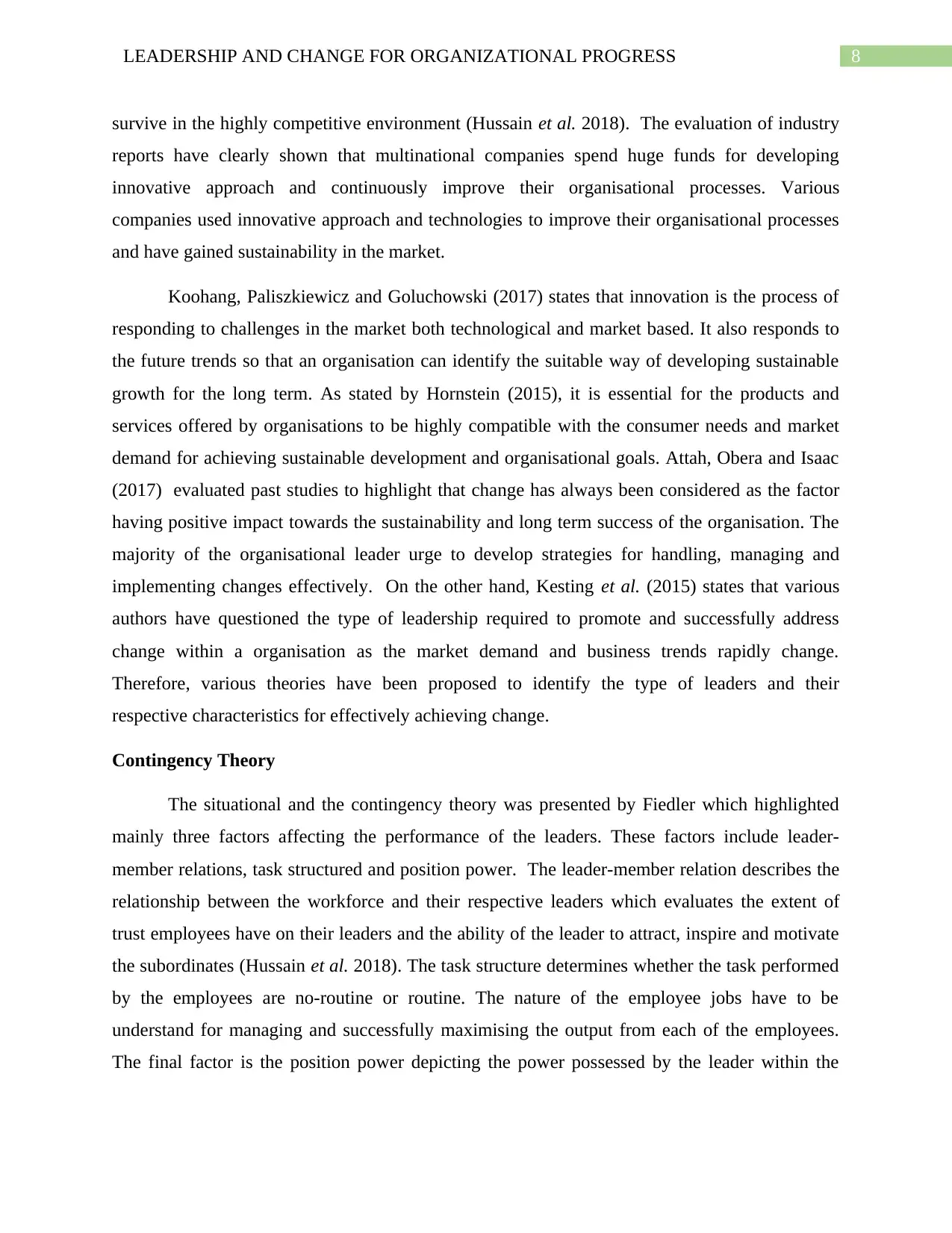
8LEADERSHIP AND CHANGE FOR ORGANIZATIONAL PROGRESS
survive in the highly competitive environment (Hussain et al. 2018). The evaluation of industry
reports have clearly shown that multinational companies spend huge funds for developing
innovative approach and continuously improve their organisational processes. Various
companies used innovative approach and technologies to improve their organisational processes
and have gained sustainability in the market.
Koohang, Paliszkiewicz and Goluchowski (2017) states that innovation is the process of
responding to challenges in the market both technological and market based. It also responds to
the future trends so that an organisation can identify the suitable way of developing sustainable
growth for the long term. As stated by Hornstein (2015), it is essential for the products and
services offered by organisations to be highly compatible with the consumer needs and market
demand for achieving sustainable development and organisational goals. Attah, Obera and Isaac
(2017) evaluated past studies to highlight that change has always been considered as the factor
having positive impact towards the sustainability and long term success of the organisation. The
majority of the organisational leader urge to develop strategies for handling, managing and
implementing changes effectively. On the other hand, Kesting et al. (2015) states that various
authors have questioned the type of leadership required to promote and successfully address
change within a organisation as the market demand and business trends rapidly change.
Therefore, various theories have been proposed to identify the type of leaders and their
respective characteristics for effectively achieving change.
Contingency Theory
The situational and the contingency theory was presented by Fiedler which highlighted
mainly three factors affecting the performance of the leaders. These factors include leader-
member relations, task structured and position power. The leader-member relation describes the
relationship between the workforce and their respective leaders which evaluates the extent of
trust employees have on their leaders and the ability of the leader to attract, inspire and motivate
the subordinates (Hussain et al. 2018). The task structure determines whether the task performed
by the employees are no-routine or routine. The nature of the employee jobs have to be
understand for managing and successfully maximising the output from each of the employees.
The final factor is the position power depicting the power possessed by the leader within the
survive in the highly competitive environment (Hussain et al. 2018). The evaluation of industry
reports have clearly shown that multinational companies spend huge funds for developing
innovative approach and continuously improve their organisational processes. Various
companies used innovative approach and technologies to improve their organisational processes
and have gained sustainability in the market.
Koohang, Paliszkiewicz and Goluchowski (2017) states that innovation is the process of
responding to challenges in the market both technological and market based. It also responds to
the future trends so that an organisation can identify the suitable way of developing sustainable
growth for the long term. As stated by Hornstein (2015), it is essential for the products and
services offered by organisations to be highly compatible with the consumer needs and market
demand for achieving sustainable development and organisational goals. Attah, Obera and Isaac
(2017) evaluated past studies to highlight that change has always been considered as the factor
having positive impact towards the sustainability and long term success of the organisation. The
majority of the organisational leader urge to develop strategies for handling, managing and
implementing changes effectively. On the other hand, Kesting et al. (2015) states that various
authors have questioned the type of leadership required to promote and successfully address
change within a organisation as the market demand and business trends rapidly change.
Therefore, various theories have been proposed to identify the type of leaders and their
respective characteristics for effectively achieving change.
Contingency Theory
The situational and the contingency theory was presented by Fiedler which highlighted
mainly three factors affecting the performance of the leaders. These factors include leader-
member relations, task structured and position power. The leader-member relation describes the
relationship between the workforce and their respective leaders which evaluates the extent of
trust employees have on their leaders and the ability of the leader to attract, inspire and motivate
the subordinates (Hussain et al. 2018). The task structure determines whether the task performed
by the employees are no-routine or routine. The nature of the employee jobs have to be
understand for managing and successfully maximising the output from each of the employees.
The final factor is the position power depicting the power possessed by the leader within the
⊘ This is a preview!⊘
Do you want full access?
Subscribe today to unlock all pages.

Trusted by 1+ million students worldwide
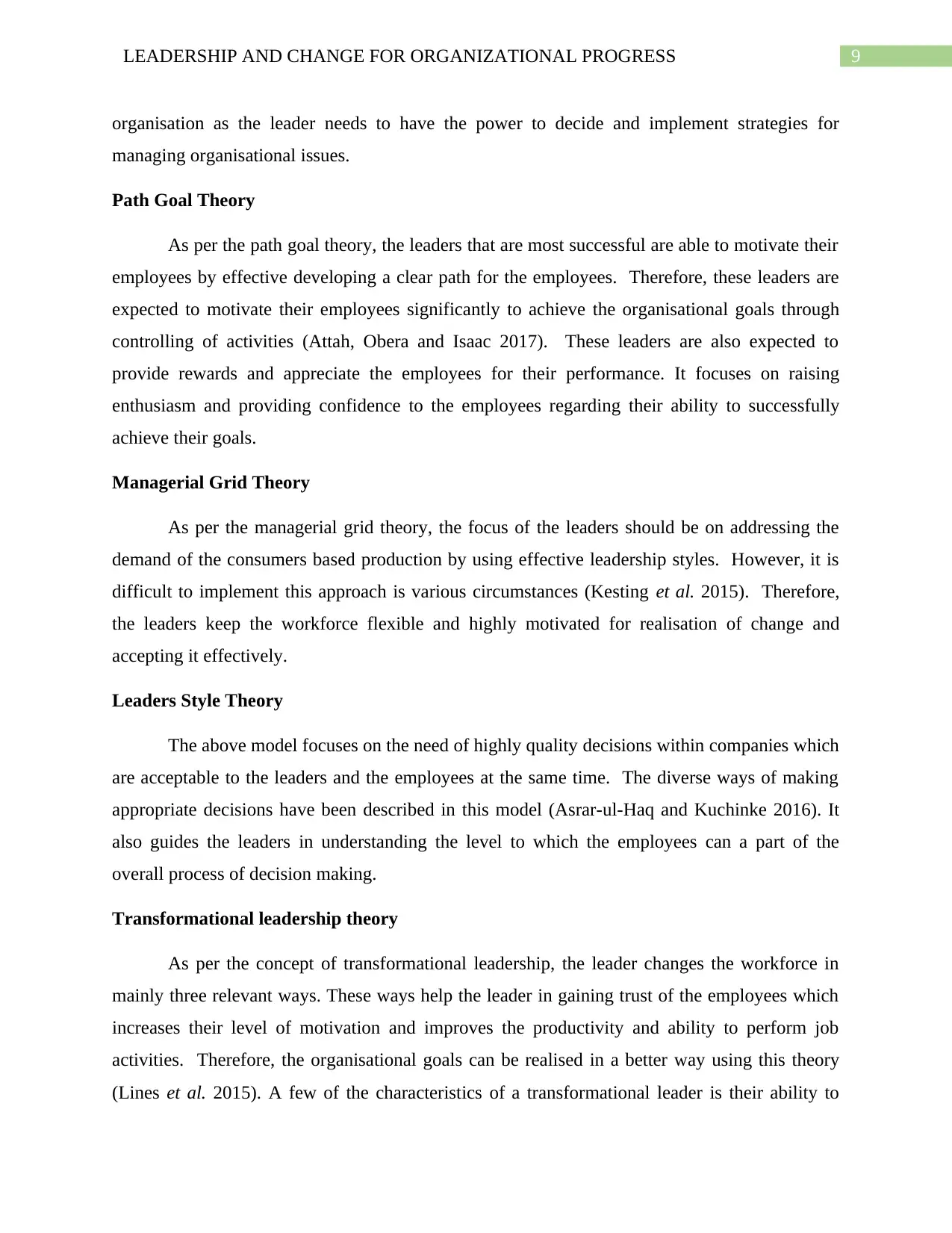
9LEADERSHIP AND CHANGE FOR ORGANIZATIONAL PROGRESS
organisation as the leader needs to have the power to decide and implement strategies for
managing organisational issues.
Path Goal Theory
As per the path goal theory, the leaders that are most successful are able to motivate their
employees by effective developing a clear path for the employees. Therefore, these leaders are
expected to motivate their employees significantly to achieve the organisational goals through
controlling of activities (Attah, Obera and Isaac 2017). These leaders are also expected to
provide rewards and appreciate the employees for their performance. It focuses on raising
enthusiasm and providing confidence to the employees regarding their ability to successfully
achieve their goals.
Managerial Grid Theory
As per the managerial grid theory, the focus of the leaders should be on addressing the
demand of the consumers based production by using effective leadership styles. However, it is
difficult to implement this approach is various circumstances (Kesting et al. 2015). Therefore,
the leaders keep the workforce flexible and highly motivated for realisation of change and
accepting it effectively.
Leaders Style Theory
The above model focuses on the need of highly quality decisions within companies which
are acceptable to the leaders and the employees at the same time. The diverse ways of making
appropriate decisions have been described in this model (Asrar-ul-Haq and Kuchinke 2016). It
also guides the leaders in understanding the level to which the employees can a part of the
overall process of decision making.
Transformational leadership theory
As per the concept of transformational leadership, the leader changes the workforce in
mainly three relevant ways. These ways help the leader in gaining trust of the employees which
increases their level of motivation and improves the productivity and ability to perform job
activities. Therefore, the organisational goals can be realised in a better way using this theory
(Lines et al. 2015). A few of the characteristics of a transformational leader is their ability to
organisation as the leader needs to have the power to decide and implement strategies for
managing organisational issues.
Path Goal Theory
As per the path goal theory, the leaders that are most successful are able to motivate their
employees by effective developing a clear path for the employees. Therefore, these leaders are
expected to motivate their employees significantly to achieve the organisational goals through
controlling of activities (Attah, Obera and Isaac 2017). These leaders are also expected to
provide rewards and appreciate the employees for their performance. It focuses on raising
enthusiasm and providing confidence to the employees regarding their ability to successfully
achieve their goals.
Managerial Grid Theory
As per the managerial grid theory, the focus of the leaders should be on addressing the
demand of the consumers based production by using effective leadership styles. However, it is
difficult to implement this approach is various circumstances (Kesting et al. 2015). Therefore,
the leaders keep the workforce flexible and highly motivated for realisation of change and
accepting it effectively.
Leaders Style Theory
The above model focuses on the need of highly quality decisions within companies which
are acceptable to the leaders and the employees at the same time. The diverse ways of making
appropriate decisions have been described in this model (Asrar-ul-Haq and Kuchinke 2016). It
also guides the leaders in understanding the level to which the employees can a part of the
overall process of decision making.
Transformational leadership theory
As per the concept of transformational leadership, the leader changes the workforce in
mainly three relevant ways. These ways help the leader in gaining trust of the employees which
increases their level of motivation and improves the productivity and ability to perform job
activities. Therefore, the organisational goals can be realised in a better way using this theory
(Lines et al. 2015). A few of the characteristics of a transformational leader is their ability to
Paraphrase This Document
Need a fresh take? Get an instant paraphrase of this document with our AI Paraphraser
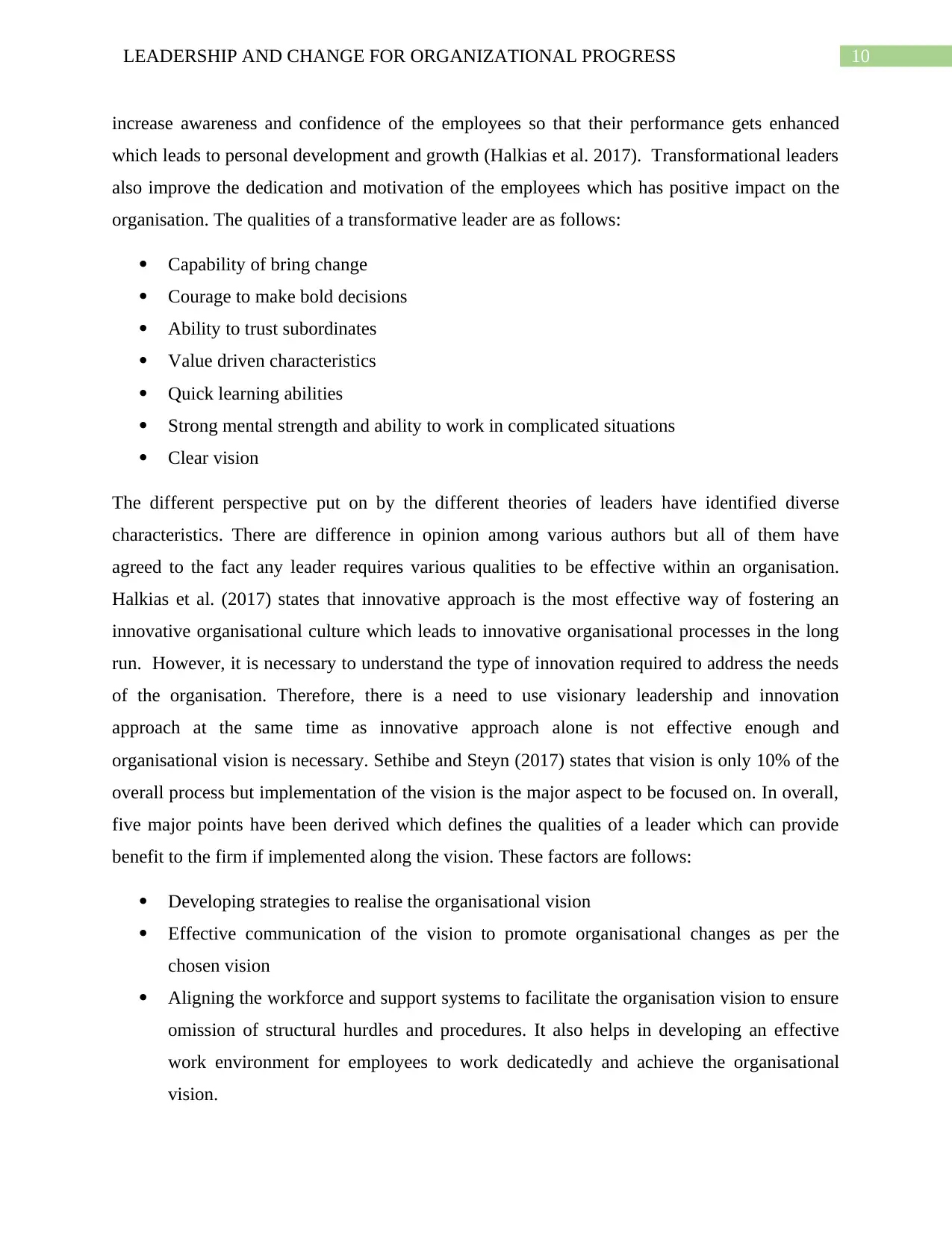
10LEADERSHIP AND CHANGE FOR ORGANIZATIONAL PROGRESS
increase awareness and confidence of the employees so that their performance gets enhanced
which leads to personal development and growth (Halkias et al. 2017). Transformational leaders
also improve the dedication and motivation of the employees which has positive impact on the
organisation. The qualities of a transformative leader are as follows:
Capability of bring change
Courage to make bold decisions
Ability to trust subordinates
Value driven characteristics
Quick learning abilities
Strong mental strength and ability to work in complicated situations
Clear vision
The different perspective put on by the different theories of leaders have identified diverse
characteristics. There are difference in opinion among various authors but all of them have
agreed to the fact any leader requires various qualities to be effective within an organisation.
Halkias et al. (2017) states that innovative approach is the most effective way of fostering an
innovative organisational culture which leads to innovative organisational processes in the long
run. However, it is necessary to understand the type of innovation required to address the needs
of the organisation. Therefore, there is a need to use visionary leadership and innovation
approach at the same time as innovative approach alone is not effective enough and
organisational vision is necessary. Sethibe and Steyn (2017) states that vision is only 10% of the
overall process but implementation of the vision is the major aspect to be focused on. In overall,
five major points have been derived which defines the qualities of a leader which can provide
benefit to the firm if implemented along the vision. These factors are follows:
Developing strategies to realise the organisational vision
Effective communication of the vision to promote organisational changes as per the
chosen vision
Aligning the workforce and support systems to facilitate the organisation vision to ensure
omission of structural hurdles and procedures. It also helps in developing an effective
work environment for employees to work dedicatedly and achieve the organisational
vision.
increase awareness and confidence of the employees so that their performance gets enhanced
which leads to personal development and growth (Halkias et al. 2017). Transformational leaders
also improve the dedication and motivation of the employees which has positive impact on the
organisation. The qualities of a transformative leader are as follows:
Capability of bring change
Courage to make bold decisions
Ability to trust subordinates
Value driven characteristics
Quick learning abilities
Strong mental strength and ability to work in complicated situations
Clear vision
The different perspective put on by the different theories of leaders have identified diverse
characteristics. There are difference in opinion among various authors but all of them have
agreed to the fact any leader requires various qualities to be effective within an organisation.
Halkias et al. (2017) states that innovative approach is the most effective way of fostering an
innovative organisational culture which leads to innovative organisational processes in the long
run. However, it is necessary to understand the type of innovation required to address the needs
of the organisation. Therefore, there is a need to use visionary leadership and innovation
approach at the same time as innovative approach alone is not effective enough and
organisational vision is necessary. Sethibe and Steyn (2017) states that vision is only 10% of the
overall process but implementation of the vision is the major aspect to be focused on. In overall,
five major points have been derived which defines the qualities of a leader which can provide
benefit to the firm if implemented along the vision. These factors are follows:
Developing strategies to realise the organisational vision
Effective communication of the vision to promote organisational changes as per the
chosen vision
Aligning the workforce and support systems to facilitate the organisation vision to ensure
omission of structural hurdles and procedures. It also helps in developing an effective
work environment for employees to work dedicatedly and achieve the organisational
vision.
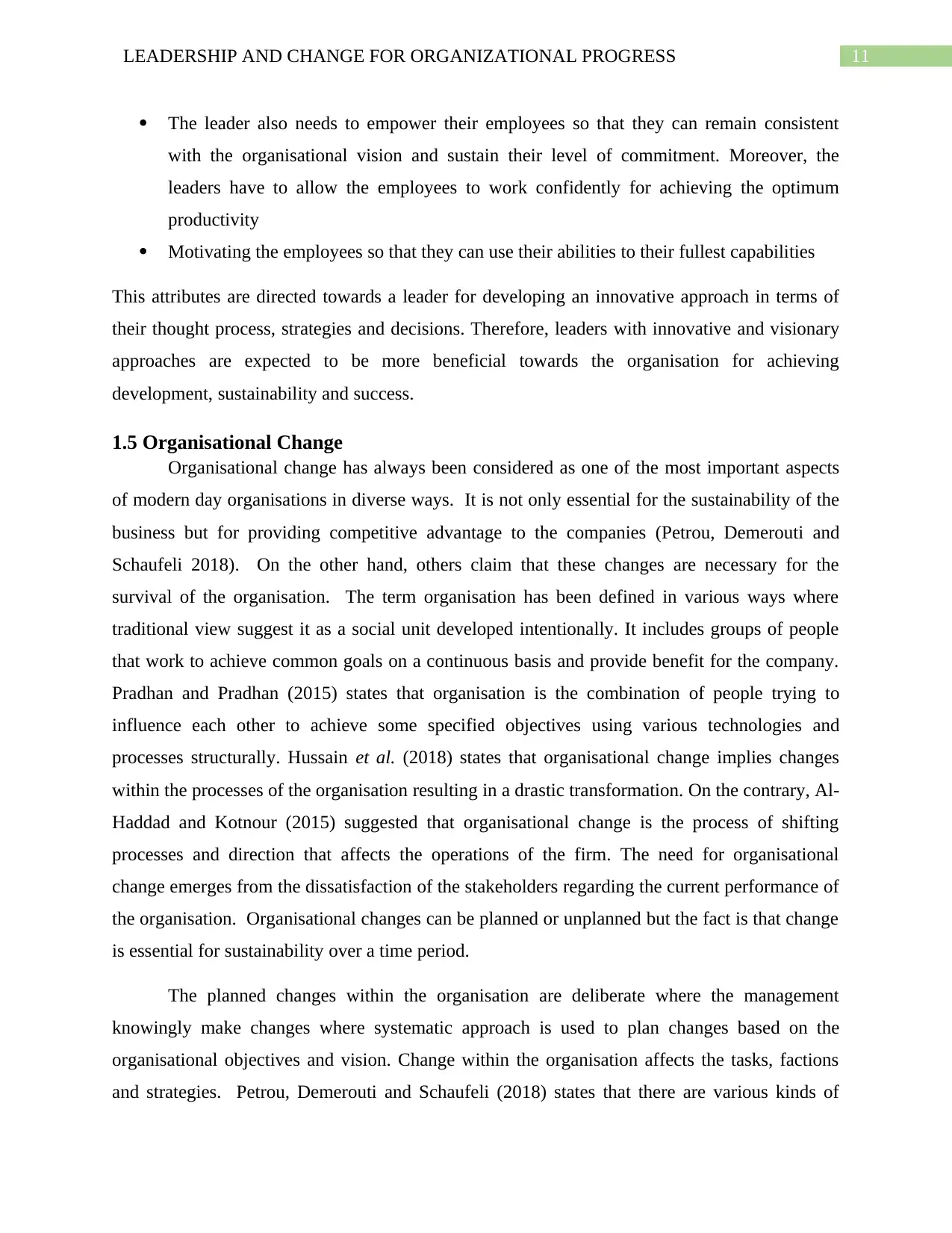
11LEADERSHIP AND CHANGE FOR ORGANIZATIONAL PROGRESS
The leader also needs to empower their employees so that they can remain consistent
with the organisational vision and sustain their level of commitment. Moreover, the
leaders have to allow the employees to work confidently for achieving the optimum
productivity
Motivating the employees so that they can use their abilities to their fullest capabilities
This attributes are directed towards a leader for developing an innovative approach in terms of
their thought process, strategies and decisions. Therefore, leaders with innovative and visionary
approaches are expected to be more beneficial towards the organisation for achieving
development, sustainability and success.
1.5 Organisational Change
Organisational change has always been considered as one of the most important aspects
of modern day organisations in diverse ways. It is not only essential for the sustainability of the
business but for providing competitive advantage to the companies (Petrou, Demerouti and
Schaufeli 2018). On the other hand, others claim that these changes are necessary for the
survival of the organisation. The term organisation has been defined in various ways where
traditional view suggest it as a social unit developed intentionally. It includes groups of people
that work to achieve common goals on a continuous basis and provide benefit for the company.
Pradhan and Pradhan (2015) states that organisation is the combination of people trying to
influence each other to achieve some specified objectives using various technologies and
processes structurally. Hussain et al. (2018) states that organisational change implies changes
within the processes of the organisation resulting in a drastic transformation. On the contrary, Al-
Haddad and Kotnour (2015) suggested that organisational change is the process of shifting
processes and direction that affects the operations of the firm. The need for organisational
change emerges from the dissatisfaction of the stakeholders regarding the current performance of
the organisation. Organisational changes can be planned or unplanned but the fact is that change
is essential for sustainability over a time period.
The planned changes within the organisation are deliberate where the management
knowingly make changes where systematic approach is used to plan changes based on the
organisational objectives and vision. Change within the organisation affects the tasks, factions
and strategies. Petrou, Demerouti and Schaufeli (2018) states that there are various kinds of
The leader also needs to empower their employees so that they can remain consistent
with the organisational vision and sustain their level of commitment. Moreover, the
leaders have to allow the employees to work confidently for achieving the optimum
productivity
Motivating the employees so that they can use their abilities to their fullest capabilities
This attributes are directed towards a leader for developing an innovative approach in terms of
their thought process, strategies and decisions. Therefore, leaders with innovative and visionary
approaches are expected to be more beneficial towards the organisation for achieving
development, sustainability and success.
1.5 Organisational Change
Organisational change has always been considered as one of the most important aspects
of modern day organisations in diverse ways. It is not only essential for the sustainability of the
business but for providing competitive advantage to the companies (Petrou, Demerouti and
Schaufeli 2018). On the other hand, others claim that these changes are necessary for the
survival of the organisation. The term organisation has been defined in various ways where
traditional view suggest it as a social unit developed intentionally. It includes groups of people
that work to achieve common goals on a continuous basis and provide benefit for the company.
Pradhan and Pradhan (2015) states that organisation is the combination of people trying to
influence each other to achieve some specified objectives using various technologies and
processes structurally. Hussain et al. (2018) states that organisational change implies changes
within the processes of the organisation resulting in a drastic transformation. On the contrary, Al-
Haddad and Kotnour (2015) suggested that organisational change is the process of shifting
processes and direction that affects the operations of the firm. The need for organisational
change emerges from the dissatisfaction of the stakeholders regarding the current performance of
the organisation. Organisational changes can be planned or unplanned but the fact is that change
is essential for sustainability over a time period.
The planned changes within the organisation are deliberate where the management
knowingly make changes where systematic approach is used to plan changes based on the
organisational objectives and vision. Change within the organisation affects the tasks, factions
and strategies. Petrou, Demerouti and Schaufeli (2018) states that there are various kinds of
⊘ This is a preview!⊘
Do you want full access?
Subscribe today to unlock all pages.

Trusted by 1+ million students worldwide
1 out of 45
Related Documents
Your All-in-One AI-Powered Toolkit for Academic Success.
+13062052269
info@desklib.com
Available 24*7 on WhatsApp / Email
![[object Object]](/_next/static/media/star-bottom.7253800d.svg)
Unlock your academic potential
Copyright © 2020–2025 A2Z Services. All Rights Reserved. Developed and managed by ZUCOL.




